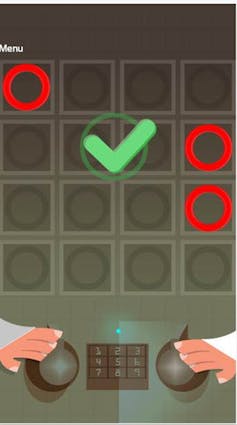As we get older we can hold less information in our minds. Whereas 16 to 17 year-olds can hold an average of 6.5 numbers in mind for a short time in their “working memory”, this drops to five numbers for 75 to 79 year-olds.
With a large-scale study using a smartphone game as part of The Great Brain Experiment, we have shown that the picture isn’t just one of cognitive decline. Instead, it appears that the way we hold items in mind – and deal with any distractions as we’re trying to remember things – changes as we get older.
Being able to effectively ignore distraction seems to be crucial for working memory. In younger adults, it has been shown that those with good working memory who can hold a lot of information in their minds are also good at ignoring distraction. Those with poor working memory seem to unnecessarily remember distractions.
It has been argued that our ability to focus on what’s important, while blocking out irrelevant information, may go some way towards explaining how much we can hold in our minds. Our ability to ignore distraction also declines with age, and it may be this that underlies the age-related decline in working memory capacity.
Ignore the yellow circles
In our experiment, 29,000 people between the ages of 18 and 69 played a smartphone game in which they had to remember the positions of red circles. As the game progressed, more and more circles were shown, until the player couldn’t remember them and started making mistakes. This told us how many items they could hold in mind – their “working memory capacity”.
While playing the game, yellow circles also appeared, which the players had to ignore. By measuring how many items players could hold in their minds when they were distracted, we could also get a measure of how well they could block out distraction.

In a recent study, which used data from the smartphone game as well as a laboratory study, we made a distinction between two different types of distraction.
The first type occurs when we are putting information into our memories. For example, you’re reading a phone number to dial into the telephone and your neighbour’s music starts playing. With the second type, the information is in our memory, and we’re trying to hold on to it. For example, you’ve finished reading and you’re just about to dial the number when the music starts. We now think that the brain deals differently with these two types of distraction.
With the smartphone game we measured how well people could ignore each type of distraction. The distracting yellow circles sometimes appeared together with the red circles (type one distraction) and sometimes afterwards (type two distraction). In this way we were able to determine how the two types are affected by ageing, and how they can explain the decline in working memory capacity.
Dealing differently with distraction
Although older adults were less able to ignore both types of distraction, it was with the second type (distraction while holding information in mind) that they showed the greatest decline. We then looked at the extent to which people’s ability to ignore the different types of distraction could explain their working memory capacity.
Older people showed the most decline in their ability to ignore distractions introduced after they had memorised information. But this didn’t show the whole picture of how their working memory changed as they aged. When they were asked to memorise information without any distractions, older people’s performance was similar to their performance when they were also being distracted at the same time. This similarity increased more and more as people got older. So this appears to be the best indicator of how well older people can store information in their working memory.
These results indicate that when older adults hold information in mind, that information is particularly vulnerable to distraction. Perhaps as a way to compensate for this, the way information is put into memory changes. Whether they are being distracted or not, older adults seem to approach the task of putting information in their mind as if they are being distracted.
These findings could lead to new ways to improve working memory in older adults. For example, they could be used to improve cognitive training, improving performance by practising cognitive tasks over an extended period. Studies have shown such scientifically informed training to be effective for younger people, but it has had limited success in older adults.
It may be that training an individual’s ability to ignore certain types of distraction is a more effective way to improve working memory. Similarly, the results could help in modifying day-to-day tasks to make them more “older adult friendly”, and improving quality of life in an ageing population.

